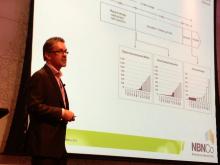NBN on track despite major data issues: NBN CTO

Despite "difficult" issues with inaccurate address data, behind-the-scenes work on the National Broadband Network (NBN) rollout is progressing rapidly, with the project to hit its peak of 6,000 connections per day by late 2013, NBN Co chief technology officer Gary McLaren has claimed.

(Credit: David Braue/ZDNet)
Offering an extensive update on the project at the NBN Realised Forum in Melbourne, McLaren said that the company has now signed up 46 access seekers — retail service providers (RSPs) and other firms who will resell NBN Co wholesale services — and that take-up rates of more than 44 percent in some areas showed that the project is "getting beyond the early adopter phase."
"Usually, an early adopter category of customer might take you to 5 to 10 percent penetration, but not nearly 45 percent of the market," McLaren said. "In the markets we've tested so far, there is a demand for speed."
The hardest part of delivering the services has been reconciling the differing sets of address data that it is working: PSMA's G-NAF (Geocoded National Address File) database; asset databases from a variety of utilities; and Telstra's own extensive copper-network ductwork maps — which NBN Co only gained access to in April.
In comparing Australian addresses stored in three separate databases, only 61 percent of the addresses were the same in each case. Of the addresses, 17 percent were the same in two of the three databases, while 22 percent of the premises — 2.9 million properties — were represented differently across each of the three databases.
Such inconsistencies have made it hard for NBN Co technicians to trace the routes of existing ducts and access points — requiring them to physically search around the area to resolve the discrepancies.
In one case, Telstra's asset map had been shifted down the street by one property. None of the addresses data matched up with the actual configuration of the houses, and it took some time for NBN Co field staff to figure out what had happened, then find the relevant ductwork.
Once the correct locations were identified, they were updated in the single SpatialInfo database, in which NBN Co began building its own asset-management dataset last year.
"We're finding that it's a very time-consuming, difficult process to take this data and use it in a way that enables us to efficiently utilise the network," McLaren said.
22 percent of the premises — 2.9 million properties — were represented differently across each of the three databases.
"This is crucial data; and we've got a problem that we've got to solve in managing our confidence in that data. Our design of the network, if it had relied on this data, would have been completely wrong."
Over 200,000 premises have already been identified as requiring Telstra to fix copper ducting that had been flooded, crushed, filled with sand, or otherwise compromised.
Addressing these issues has been "the focus of our activity over the last six months," said McLaren, who praised Telstra for its demonstrated ability to work quickly and effectively with NBN Co staff.
"It's Telstra's obligation to find out where areas of duct needs to be remediated," McLaren said, "and they are doing that at a faster rate than expected. It's small numbers yet, but they have been quite keen to work with us through the management of the data issues."
McLaren also addressed concerns over NBN Co's rollout in greenfields estates, which has been a regular target for Shadow Communications Minister Malcolm Turnbull and other critics of the project.
While the network has passed around 20,000 lots, he said that 50,000 more are underway, while 100,000 are under planning. However, the fact that most greenfields estates still have few completed houses — to which no NBN services had yet been commissioned — has kept connection numbers low in the near term.
Refinements to rollout techniques have dropped the per-premises rollout cost over time, McLaren said, arguing that improving management of NBN Co's costs has reduced the risk of mooted cost blowouts — and has kept the massive effort on track to hit its peak rollout pace by late 2013.
Premises connections are "the most expensive component of the network, and we've got good control of the cost element as we go into the build next year," he said. "We will be building this network at a rate of 6,000 premises per day by the second half of next year.
"It might look a bit slow at this point, and there has been a lot of inertia to get things going, but there's a mountain of work going on behind the scenes. Once it starts going, it will really start to happen at the speed we've been talking about."